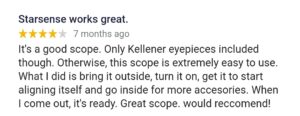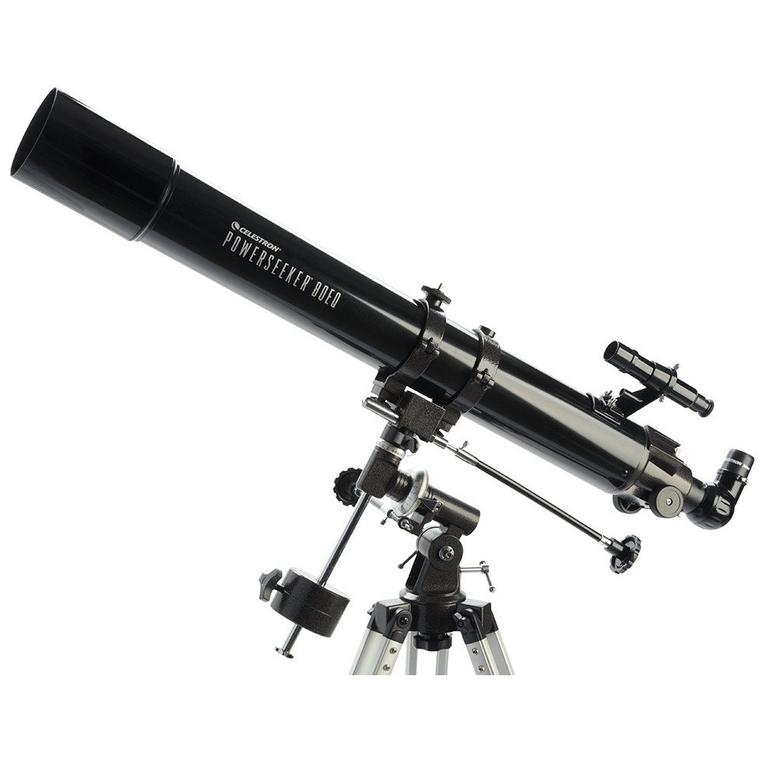*This post may contain affiliate links. This means we may make a commission if you purchase an item using one of our links*
Welcome to my Celestron 21048 PowerSeeker 80EQ Review!
In this review I’ll cover the pros, cons and the 80EQ’s features to ultimately help you decide on whether the system is worth investing in or a beginner level device that you should skip out on.
Overview
Table of Contents
- Full Name: Celestron PowerSeeker 80EQ
- Type: Refractor
- Aperture: 80mm (3.2″)
- Focal length: 900mm
- Focal ratio: f/11
- Dimensions & Weight: 98.1 x 32 x 24.4 centimetres & 6.3kg
- Included eyepieces: 20mm kellner and 4mm Ramsden
- Rating: 4/5
Pros
- A good amount of accessories provide
- Good value for money
- A decent mount
- Minimal maintenance
Cons
- A bit limited in performance
- The 675x magnification marketing is a lie
- PERFECT ENTRY-LEVEL TELESCOPE: The Celestron PowerSeeker 80EQ is an easy-to-use and powerful telescope. This 80mm refractor telescope offers enough light gathering ability to see planets, the Moon's craters, distant stars, the Orion Nebula, and more.
- MANUAL GERMAN EQUATORIAL MOUNT: With its slow-motion altitude rod, the German Equatorial mount allows you to navigate the sky with ease. Find celestial objects quickly and follow them smoothly & accurately as they appear to drift across the night sky.
- COMPACT AND PORTABLE: The ideal telescope for adults and kids to use together, the PowerSeeker is compact, lightweight, and portable. Take it to your favorite campsite, a dark sky observing site, or simply the backyard.
- MULTIPLE ACCESSORIES: The Celestron PowerSeeker 80EQ Telescope comes with 2 quality eyepieces (20mm and 4mm) plus a 3x Barlow lens to triple the power of each. You'll also receive a FREE download of one of the top-rated astronomy software programs.
- UNBEATABLE WARRANTY & SUPPORT: Buy with confidence from Celestron, a leading telescope brand in California since 1960. Your purchase includes a 2-Year US Warranty and unlimited support from our team of US-based experts.
How Do The PowerSeeker 80EQ’s Optics Work?
Telescopes tend to come in one of 3 optical variations within their tubes, with these 3 being reflector, refractor and compound optics. The PowerSeeker in this case is a refractor based telescope which means the optics within are glass lenses enclosed inside the tube. (here’s a more in depth look at each variation).
As is the case will all 3 different variations, they will have their pros and cons, which is what I’ll go into more detail next.
The pros of the optics within the PowerSeeker 80EQ are as such :
- Because refractor devices always use enclosed tubes, it also means that the optics within won’t need to be cleaned or collimated all the time
- The lens allows the device to double as a spotting scope for viewing things on Earth along with extraterrestrial objects in outer space.
- The images will generally be sharper because misalignment isn’t very common with the refractor lens found within.
As for the cons, they include the following :
- As the refractor lenses are thicker, it results in the achromatic lens to suffer from chromatic aberration therefore, certain lights i.e. ultraviolet light won’t be accurately captured. (this can be minimised if the focal ratio is high enough)
- Refractor optics also tend to be more expensive than a similarly powered reflector counterpart
- The other 2 optical variations are also a lot better at viewing faint objects in space
The refractor optics within the 80EQ are actually decent and will be more than useable if you decide to pick the device up. Of course I’m sure you’re curious as to what you’ll be able to view with it based on the specifications, which of course is what I’ll be covering next.
What Do The PowerSeeker 80EQ’s Specifications Mean?
The 80EQ has an aperture of 80mm (3.15″),a focal length of 900mm resulting a focal ratio of f/11. What this means is that theoretically the device will be able to achieve a max magnification 225x although considering the device is a cheaper, real world use would mean it’d probably achieve around 150 – 160x max of useable magnification.
The focal ratio of f/11 means that the chromatic aberration refractors tend to suffer from will minimised and the views will be narrower too, making a solid scope go planetary viewing.
As for what you’ll be able to view with the PowerSeeker 80EQ, it can be following objects in space :
- The moon and its craters in reasonable detail
- Jupiter in reasonable detail
- Saturn and an outline of its rings near max power
- Mars, Mercury and Venus should be visible although not in much detail
- You should be able to make out some star clusters, a few galaxies as bright dots and maybe some asteroids if you’re able to track them and if they’re near enough to you.
The weight of the 80EQ is very manageable coming in at 6.3kg when everything is assembled. As for the dimensions of the tube, it comes in at 98.1 x 32 x 24.4 centimetres.
There isn’t much information on the size of the tripod provided but, going off of information from other similar sized telescopes, it’ll likely allow the 80EQ to reach a a maximum height or around 1.3m.
Accessories Included In The Box
The 80EQ comes with a fair few accessories within such as one 1.25″ kellner eyepieces at 20mm and another Ramsden 4mm, a PowerSeeker 3x Barlow lens, a smartphone adapter, an EQ-1 German equatorial mount, a tripod among other documentation.
The accessories aren’t terrible considering the price but the potential max magnification of 675x when using the equipment is a bit overkill and won’t really amount to much usability.
As for the mount, it’s the same one the larger PowerSeeker EQ telescopes provide which when used with those systems suffered a lot from stability issues as they were too big for the mount however, for the 80EQ the mount is actually very solid and transitions quite smoothly when in use.
What Are Users Of The PowerSeeker 80EQ Saying
People seem to genuinely like the 80EQ and believe it to be a solid beginner level telescope, particularly when it can be found on a deal.



Other Alternatives Worth Checking Out
If the power of the PowerSeeker isn’t quite to your liking and you want to keep to a fairly budget of $300, we’ve created a list covering some of the best budget telescope alternatived here.
If you’re also interested in some better refractor systems, maybe this list may help you out.
Summary
The PowerSeeker 80EQ is a solid beginner level telescope which can sometimes even be bought at a steal for less that $100 even though on average it tends to be $120 – $150.
It does have its limitations as a result of its pricing and of course if you were to buy it, an upgrade on the eyepieces would more than likely be necessary for the best experience but, as a first time telescope I can’t say it’d be a bad option to go for.


